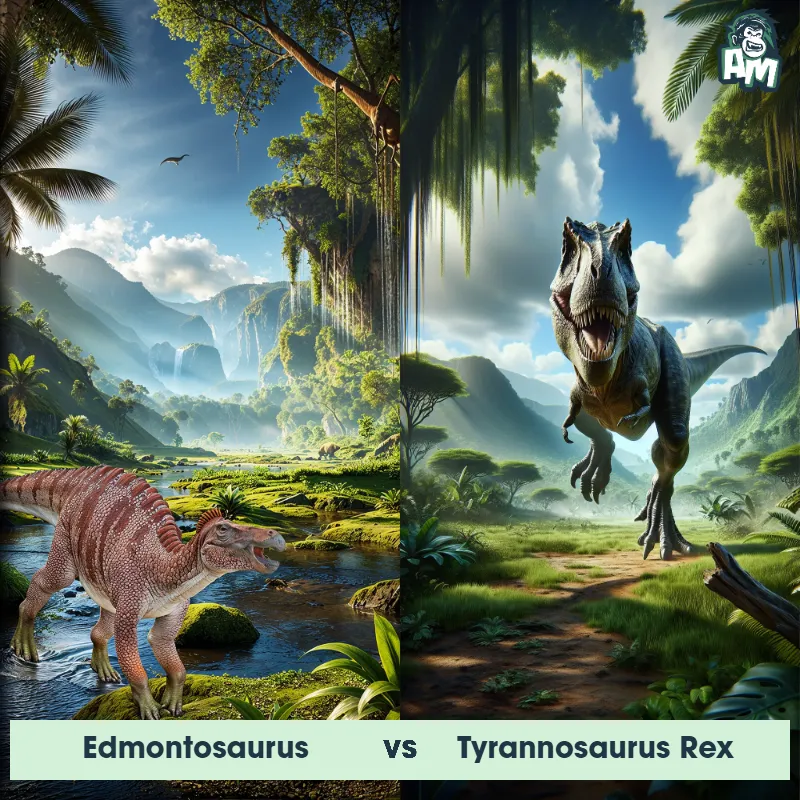The Edmontosaurus
Edmontosaurus, also known as the "duck-billed dinosaur," was a herbivorous dinosaur that lived during the Late Cretaceous period. It had a long, flat skull with a wide beak, perfect for cropping vegetation. Its body measured around 40 feet long and had a sail-like structure on its back. Edmontosaurus walked on four legs and had hoof-like claws on its feet.

| Edmontosaurus | |
|---|---|
| Size | Up to 40 feet (12 meters) long |
| Weight | Up to 4 tons (3,600 kilograms) |
| Speed | 16-20 mph (26-32 km/h) |
| Key Strength | Powerful tail for defense |
| Biggest Weakness | Vulnerable sides due to lack of armor |
| Scientific Name | Edmontosaurus regalis |
| Family | Hadrosauridae |
| Habitat | Woodlands and floodplains |
| Geography | North America |
| Diet | Herbivore |
| Lifespan | 15 years - 20 years |

The Edmontosaurus
Edmontosaurus, also known as the "duck-billed dinosaur," was a herbivorous dinosaur that lived during the Late Cretaceous period. It had a long, flat skull with a wide beak, perfect for cropping vegetation. Its body measured around 40 feet long and had a sail-like structure on its back. Edmontosaurus walked on four legs and had hoof-like claws on its feet.
Fun Fact: One fun fact about Edmontosaurus is that it is believed to have lived in large herds, possibly for protection against predators or foraging purposes.
| Edmontosaurus | |
|---|---|
| Size | Up to 40 feet (12 meters) long |
| Weight | Up to 4 tons (3,600 kilograms) |
| Speed | 16-20 mph (26-32 km/h) |
| Key Strength | Powerful tail for defense |
| Biggest Weakness | Vulnerable sides due to lack of armor |
| Scientific Name | Edmontosaurus regalis |
| Family | Hadrosauridae |
| Habitat | Woodlands and floodplains |
| Geography | North America |
| Diet | Herbivore |
| Lifespan | 15 years - 20 years |
Edmontosaurus Matchups
We use AI to simulate matchups between the Edmontosaurus and other animals. Our simulation considers size, strength, and natural predatory behaviors to determine the most likely outcome.

Can't find the Matchup you want?
Create Your Own MatchupEdmontosaurus: Diet, Predators, Aggression, and Defensive Behaviors
What did Edmontosaurus eat?
Edmontosaurus were herbivorous dinosaurs, primarily feeding on plants such as leaves, twigs, and fruits. They were known to browse on a wide variety of plant species, utilizing their complex teeth to efficiently chew through vegetation.
Did Edmontosaurus have any predators?
Yes, Edmontosaurus had several predators, including large theropod dinosaurs such as Tyrannosaurus rex and Albertosaurus. These predators would hunt and prey upon juvenile and weak Edmontosaurus individuals, taking advantage of their size and vulnerability.
Were Edmontosaurus aggressive?
Edmontosaurus were generally not considered aggressive dinosaurs. They were more likely to rely on their size and herding behavior for protection rather than being confrontational with predators or other species.
Did Edmontosaurus fight?
While Edmontosaurus were not known for engaging in physical fights with each other or other dinosaurs, they may have exhibited dominance behaviors within their own herds. This could involve displays of size and strength rather than actual physical combat.
How did Edmontosaurus defend themselves?
Edmontosaurus likely relied on their large size, herding behavior, and swift movement to defend themselves against predators. By sticking together in groups, they could deter or avoid potential threats and increase their chances of survival.
What was Edmontosaurus' biggest weakness in a fight?
One of the biggest weaknesses of Edmontosaurus in a fight would be their lack of natural weaponry such as sharp teeth or claws. While they could potentially use their size and weight as a defense mechanism, they were not equipped for direct physical combat with predators that possessed hunting adaptations.
Fun Fact: Another interesting fact about Edmontosaurus is that studies suggest it may have been able to reach speeds of up to 28 miles per hour, making it a relatively fast dinosaur for its size.
Fun Fact: Edmontosaurus had hundreds of teeth in its mouth arranged in multiple rows, allowing it to efficiently chew tough plant material.












